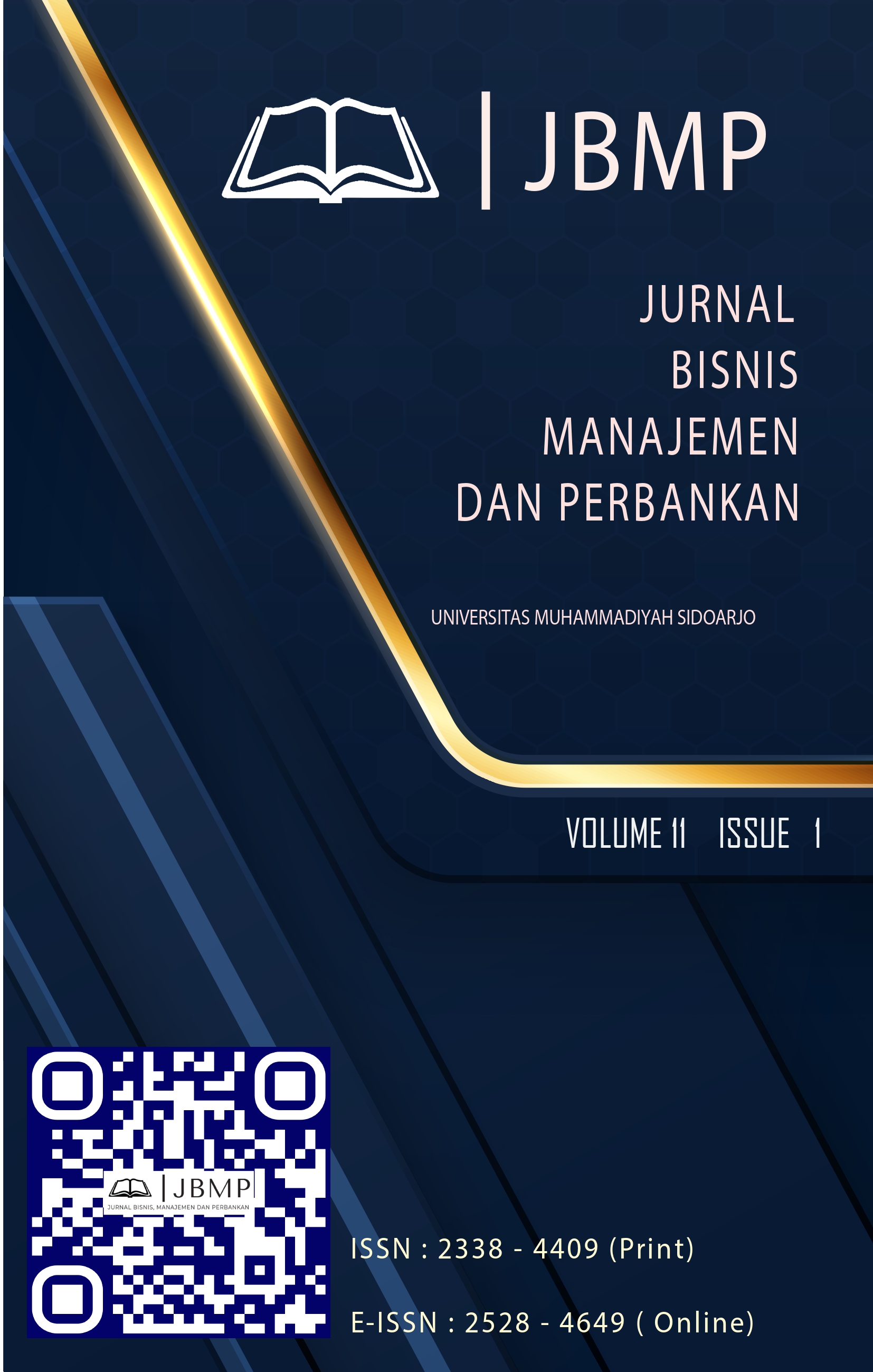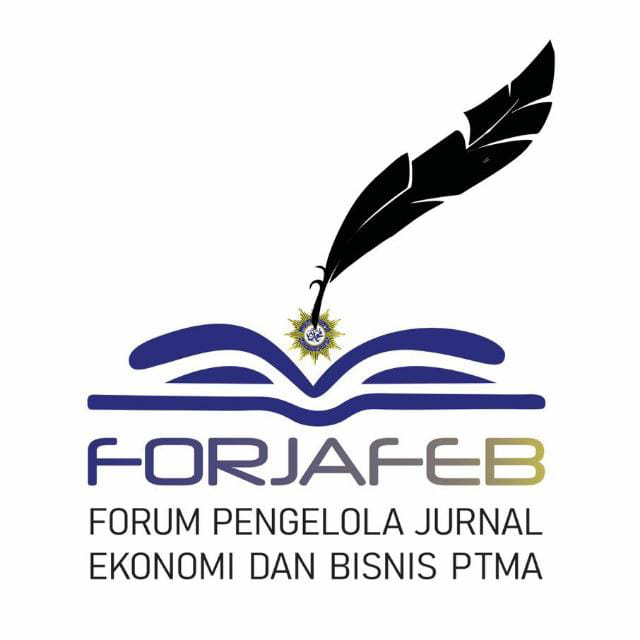Peer-to-Peer Lending's Influence on Bank Performance: Core Capital Perspectives
Pengaruh Pinjaman Antar Rekan terhadap Kinerja Bank: Perspektif Modal Inti
DOI:
https://doi.org/10.21070/jbmp.v11i1.1963Keywords:
Peer-to-peer lending, bank performance, fintech, conventional banks, regulationAbstract
The study intends to evaluate the influence of peer-to-peer lending (P2P lending) on banks performance, focusing on differences in core capital classifications. Using data from the Financial Service Authority and Bank Indonesia websites, the analysis spans the fourth quarter of 2021 to the third quarter of 2023. The results reveal that P2P lending negatively affects bank performance, with more significant adverse impacts observed in banks with lower core capital, categorized under KBMI 1 and 2, compared to KBMI 3 and 4. These findings underscore the need for regulatory policies tailored to address the vulnerabilities of smaller banks, including measures to promote consolidation and capital augmentation. This study offers valuable insights into the interplay between financial technology and banking regulations, providing practical implications for policymakers and stakeholders.
References
Aaker, D. A., & Keller, K. L. (1990). Consumer Evaluations of Brand Extensions. Journal of Marketing, 54(1), 27–41.
Abuamsha, M. K. (2022). The role of the banking sector in financing the real estate and contracting sector in the Palestinian territories. International Journal of Housing Markets and Analysis, 15(2), 357–374. https://doi.org/10.1108/IJHMA-11-2020-0135
Agostino, M., Ruberto, S., & Trivieri, F. (2023). The role of local institutions in cooperative banks ’ efficiency. The case of Italy. International Review of Economics and Finance, 84(December 2020), 84–103. https://doi.org/10.1016/j.iref.2022.11.001
Amir, M., & Amri, A. (2022). The Effect of Loan to Deposit Ratio ( LDR ) on Return On Assets ( ROA ) at PT . Bank Mandiri ( Persero ) Tbk . Jurnal Ilmiah Ilmu Administrasi Dan Manajemen, 15(3).
Berger, A. N. (1995). The Profit-Structure Relationship in Banking Tests of Market-Power and Efficient-Structure Hypotheses. Journal of Money, Credit and Banking, 27(2), 404–431.
Chen, Z., Li, K., & He, L. Y. (2020). Has Internet Finance Decreased the Profitability of Commercial Banks?: Evidence from China. Emerging Markets Finance and Trade, 56(13), 3015–3032. https://doi.org/10.1080/1540496X.2019.1624159
Christensen, C. M. (1997). The Innovator’s Dilemma: When New Technologies Cause Great Firms to Fail. Harvard Business School Press.
Dasilas, A., & Karanović, G. (2023). The impact of FinTech firms on bank performance: evidence from the UK. EuroMed Journal of Business. https://doi.org/10.1108/EMJB-04-2023-0099
Fidanoski, F., & Sergi, B. S. (2017). What does affect profitability of banks in Croatia ? Competitiveness Review: An International Business Journal, 28(4), 338–367. https://doi.org/10.1108/CR-09-2016-0058
Hamid, F. S., & Ibrahim, M. H. (2021). Competition, diversification and performance in dual banking : a panel VAR analysis. Economic Research-Ekonomska Istraživanja, 34(1), 194–220. https://doi.org/10.1080/1331677X.2020.1782242
Hodula, M. (2023). Interest rates as a finance battleground ? The rise of Fintech and big tech credit providers and bank interest margin ✰. Finance Research Letters, 53(February), 103685. https://doi.org/10.1016/j.frl.2023.103685
Khan, H. H., Ahmad, R. B., & Chan, S. G. (2018). Market structure , bank conduct and bank performance : Evidence from ASEAN. Journal of Policy Modeling, 40(5), 934–958. https://doi.org/10.1016/j.jpolmod.2018.02.001
Kharrat, H., Trichilli, Y., & Abbes, B. (2023). Relationship between FinTech index and bank ’s performance : a comparative study between Islamic and conventional banks in the MENA region. Journal of Islamic Accounting and Business Research. https://doi.org/10.1108/JIABR-03-2022-0081
Khatima, A. K., Anwar, A. I., & Zamhuri, M. Y. (2023). The Effect of Financial Technology ( FINTECH ) on Banking Financial Profits in Indonesia (Case Study on BUMN Bank KBMI 4 ). Jurnal Ekonomi, 12(01), 1407–1414.
Kohardinata, C., Soewarno, N., & Tjahjadi, B. (2020). Indonesian peer to peer lending (P2P) at entrant’s disruptive trajectory. Business: Theory and Practice, 21(1), 104–114. https://doi.org/10.3846/btp.2020.11171
Kohardinata, C., Suhardianto, N., & Tjahjadi, B. (2020). Peer-to-Peer Lending Platform: From Substitution to Complementary for Rural Banks. Business: Theory and Practice, 21(2), 713–722.
Kumar, S., Li, A., Wong, H., Chauhan, H., & Shubhankar, Shobhit Oetama, I. (2023). Indonesia’s Fintech Industry is Ready to Rise. In BCG Publications (Issue March). https://www.bcg.com/publications/2023/fintech-industry-indonesia-growth
Lee, C. C., Li, X., Yu, C. H., & Zhao, J. (2021). Does fintech innovation improve bank efficiency? Evidence from China’s banking industry. International Review of Economics and Finance, 74(June 2020), 468–483. https://doi.org/10.1016/j.iref.2021.03.009
Lestari, H. S., Chintia, H., & Akbar, I. C. (2021). Determinants of Net Interest Margin on Conventional Banking : Evidence in Indonesia Stock Exchange. Jurnal Keuangan Dan Perbankan, 25(1), 104–116.
Murinde, V., Rizopoulos, E., & Zachariadis, M. (2022). The impact of the FinTech revolution on the future of banking : Opportunities and risks. International Review of Financial Analysis, 81(March), 102103. https://doi.org/10.1016/j.irfa.2022.102103
Oino, I. (2018). Research in International Business and Finance Impact of regulatory capital on European banks fi nancial performance : A review of post global fi nancial crisis. Research in International Business and Finance, 44(July 2017), 309–318. https://doi.org/10.1016/j.ribaf.2017.07.099
Okubo, Y., & Adrian, G. (2023). Navigating the fintech landscape: Indonesias journey and potential. East Ventures. https://east.vc/news/insights/navigating-the-fintech-landscape-indonesias-journey-and-potential/
Peraturan Otoritas Jasa Keuangan Republik Indonesia Nomor 12/POJK.03/2021 Tentang Bank Umum, Pub. L. No. Nomor12/POJK.03/2021 (2021).
Phan, D. H. B., Narayan, P. K., Rahman, R. E., & Hutabarat, A. R. (2020). Do financial technology firms influence bank performance ? Pacific-Basin Finance Journal, 62(September 2019), 101210. https://doi.org/10.1016/j.pacfin.2019.101210
Ramlall, I. (2018). FinTech and the Financial Stability Board. In Understanding Financial Stability (The Theory and Practice of Financial Stability, Vol. 1) (pp. 71–81). Emerald Publishing Limited.
Saiedi, E., Mohammadi, A., Broström, A., & Shafi, K. (2022). Distrust in Banks and Fintech Participation: The Case of Peer-to-Peer Lending. Entrepreneurship: Theory and Practice, 46(5), 1170–1197. https://doi.org/10.1177/1042258720958020
Saksonova, S. (2014). The Role of Net Interest Margin in Improving Banks ’ Asset Structure and Assessing the Stability and Efficiency of their Operations. Procedia - Social and Behavioral Sciences, 150, 132–141. https://doi.org/10.1016/j.sbspro.2014.09.017
Scott, S. V, Reenen, J. Van, & Zachariadis, M. (2017). The long-term effect of digital innovation on bank performance : An empirical study of SWIFT adoption in financial services. Research Policy, 46(5), 984–1004. https://doi.org/10.1016/j.respol.2017.03.010
Siek, M., & Sutanto, A. (2019). Impact Analysis of Fintech on Banking Industry. 2019 International Conference on Information Management and Technology (ICIMTech), 1(August), 356–361.
Tang, H. (2019). Peer-to-Peer Lenders Versus Banks: Substitutes or Complements? Review of Financial Studies, 32(5), 1900–1938. https://doi.org/10.1093/rfs/hhy137
Tobing, J. D. T., & Wijaya, C. (2020). The Effect of Peer to Peer Lending and Third Party Payments on Coventional Commercial Bank Profitability in Indonesia. International Journal of Management, 11(5), 691–701. https://doi.org/10.34218/IJM.11.5.2020.062
Wahyuni, S., Bustami, A., Fitriah, R. R. A., Fajri AF, M. S., & Yudaruddin, R. (2024). The impact of fintech peer-to-peer lending and Islamic banks on bank performance during COVID-19. Banks and Bank Systems, 19(1), 195–207. https://doi.org/10.21511/bbs.19(1).2024.17
Wang, H., Mao, K., Wu, W., & Luo, H. (2023). Fintech inputs, non-performing loans risk reduction and bank performance improvement. International Review of Financial Analysis, 90(July). https://doi.org/10.1016/j.irfa.2023.102849
Yudaruddin, R. (2022). Financial technology and performance in Islamic and conventional banks. Journal of Islamic Accounting and Business Research, 14(1). https://doi.org/10.1108/JIABR-03-2022-0070
Zhao, J., Li, X., Yu, C., Chen, S., & Lee, C. (2022). Riding the FinTech innovation wave: FinTech, patents and bank performance. Journal of International Money and Finance, 122, 102552. https://doi.org/10.1016/j.jimonfin.2021.102552
Downloads
Published
Issue
Section
License
Copyright (c) 2025 Chaerani Nisa, Irma Sari Permata, Mulyadi, Syafira Ahyani

This work is licensed under a Creative Commons Attribution 4.0 International License.








